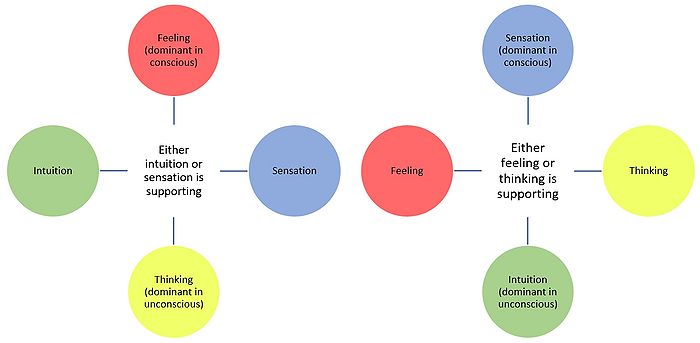Jung's personality Theory
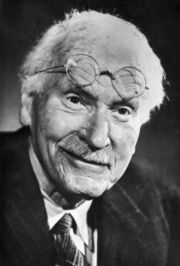
In the following it will be explained how Jung saw the mind and especially how it can be used I management when different teams and workgroups are formed. Projects managers are facing 3 main problems today; The complexity of projects, how humans are going to behave in different environments and situations and the many uncertainty’s in a project. How to deal with human factors on projects will be the focus of this article.
Because projects today are more complicated then seen in the past it is often necessary to form work taskforces that mix different types of people. People with different curriculums are put together to best and most efficiently solve the given tasks. Today’s open culture and dynamics of company’s forces the work environments to constantly reform and evolve the workgroups. Because these groups often are temporary it is crucial that the team is grouped efficiently before the project can be a success.
To form a successful group, you must have a basic understanding of all the potential group members. This includes understanding how each person is motivated, how they gather information and how they make decisions. A projects manager needs to ensure that every team members skills are put to best use and that the way they interact is properly received by the fellow team members. With a clear understanding of each team members psyche a project manager can assign the right tasks to the right people, not only based on their individual expertise areas.
Contents |
The Basics
The basis on understanding human behaver is based on the work of psychiatrist Carl Gustav Jung. His research was centered around the psychoanalyses of humans and is today very often used to coordinate and make teams in work situations. If a project manager understands the basis of Jung’s personality theory’s he will be capable of grouping teams based on their individual personality trades. If teams are grouped based on this theory the team will complement each other and many conflicts can be avoided. Jung meant that people was defined by their characteristics within the following three groups:
- Extraversion – introversion
- Sensing – intuition
- Thinking – feeling
Jung’s work is built around different personality types and analysis of dreams. During his professional life, he was very influenced by Freud and big parts of Jung’s work is developed on Freuds thoughts of the human mind. Freud and Jung came to a professional disagreement and this caused them to go their separate ways both personally and professionally. This was due to Freuds focus on the past and Jung’s focus on the present. Jung meant that the present had much more influence on the mind than the past. Jung’s personality theory is especially of interest for project managers because it connects the psychoanalysis way of thinking with today’s personality tests. This is because Jung, opposed to e.g. Freud, sees the individual mind as energy that influences the future of the individual. The energy decides how the future should look like and therefore forms e.g. hope, goals, desires etc. for the future. Where is many like Freud only focused on the past.
Carl Gustav Jung
C. G. Jung was born in Switzerland on the 26. Of July 1875 and died the 6. Of June 1961. Jung was a psychiatrist and later also became a psychoanalyst at the Burghölzli hospital, which is the psychiatric hospital of Zürich university. During Jung’s career, he founded the analytical psychology and is today especially known for his work with dream analysis, human psyche and personality theory.
As Jung became more and more famous for his work, Sigmund Freud reached out and the two men decided to collaborate on a joint vision regarding the human psychology. Because of this cooperation between the two, Jung’s work became very influenced by Freud’s visions and their work can in some aspect be difficult to distinguish between. Eventually Jung choose to focus on the present while Freud continued to focus on the past and the subject’s child hood. This led to a break between the two, which had a personal and a work vise influence on Jung.
Jung’s focus on the present day is what makes his personality theory’s especially relevant for project managers. One of Jung’s central concepts was the individuation. This concept is a part of the analytical psychology and is the concept on how humans has a lifelong process of differentiation of the self-persona. According to Jung the consciousness and unconsciousness of the individual is in a lifelong process of differentiating the self-persona. One part of this concept is the extraversion and introversion aspects, which will be explained in detail later in the article.
Jung’s perspective on the mind
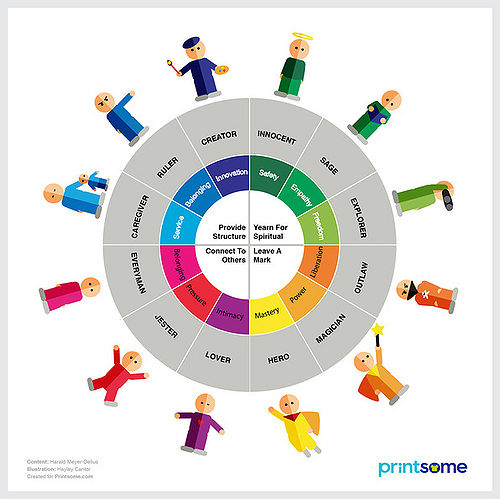
Jung saw the mind as two different parts and how they interacted on each other. He distinguished between the persona and the shadow of the mind. The persona is defined as how we present ourselves to the world, the picture we let others see. While our shadow is the compressed part of us. The shadow often hides our fears and flaws. Besides this Jung noted that the mind consists of a personal unconscious and a collective unconscious. The personal unconscious is the persons own memories and experiences while the collective unconscious is the experiences of the species that have been past trough by our DNA. Jung described the different types of collective unconscious personality’s as archetypes. These types are universal and can be used to identify our persona and therefore get a deeper understanding of why different people act as they do. From greek the word arche means original and typos means pattern. The Archetypes is in its basic 12 different personality types that describes the original pattern of a mind. However, Jung pointed that there is as many archetypes as there are situations in life.
”There are as many archetypes as there are typical situations in life. Endless repetition has engraved these experiences into our psychic constitution, not only in the forms of images filled with content, but at first only as forms without content, representing merely the possibility of a certain type of perception and action.” C. G. Jung (1981) [3].
An archetype is formed by the evolution of humans, just as the rest of our organs etc. All humans know of them, but they show themselves in different forms from individual to individual. The archetypes are dynamic and will interact differently in each person, this leads to the formation of each individual’s personality type. That is the archetypes are the foundation for the personality of the individual [3].
Personality types
Jung distinguish between to bases of personalities, extroverts and introverts. If a person is categorized as extrovert the person is very outgoing and prefers to be among people to socialize. In opposite, the introvert person prefers to be alone and is much more comfortable in his own company. In other words, an introvert is stimulated from within himself while an extrovert person gets stimulated by outside environments. Jung himself explained this in one of his books:
"....The introvert's attitude to the object is an abstracting one.... he is always facing the problem of how libido can be withdrawn from the object...... The extravert, on the contrary, maintains a positive relation to the object. To such an extent does he affirm its importance that his subjective attitude is continually being orientated by, and related to the object...." Psychological Types by C. G. Jung 1921 [4].
As an example, we could look at Julie. Julie prefers to spend her Friday night out with friends and often she has plans the entire weekend. She loves to interact with lots of different people and she probably has a big circle of friends. On the contrary Dan prefers to stay home, read books and watch movies by himself all weekend. Dan most likely only have few, but close friends. Julie is an extrovert while Dan is an introvert person. However, it is important to know that there is no such person that is 100 % extrovert or introvert, as Jung also said himself:
"There is no such thing as a pure introvert or extrovert. Such a person would be in the lunatic asylum. " C. G. Jung [5].
When people are grouped into introvert – extroverts Jung subdivides people even further. People are categorized after how they perceive the world and how they make decisions. Jung categorize after the following four groups, called the functional types:
The irrational functions - How we perceive environments and gather information
- Sensing - When a person is in this group the person likes to use aesthetics in everyday situations. The person prefers that everything is in line, symmetric and so on. Dan e.g. prefers that if there is one lamp on his desk, there must be one more opposite of the first to balance the desk. If things are in ‘balance’ Dan feels satisfied and can better focus on the task ahead of him.
- Intuition - Opposite of sensation is the people who goes for their intuition. When a person relay mostly on intuition he uses his unconscious to decide in all kinds of situations and environments. When Julie decorates her living room she might use two different designs of chairs and a third design for the couch. A person like Dan would have not liked if the furniture were not part of a matching set.
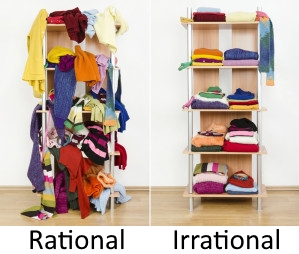
The rational functions - How we make decisions or judge
- Thinking - When a person uses facts and reasoning to decide in situations they encounter. Often an engineer is in this category while an artist feels the situations and decides upon that. A person in this category asses the different outcomes and analyses the situation before deciding.
- Feeling - A person who relies on feelings uses his personal experience and goes with whatever feels right. This would typically be a creative person.
Irrational vs Rational personality
If a person is dominantly irrational he likes to organize and create order in chaos. He sees the situations and quickly realizes where decisions must be made. Irrational people makes plans, schedules, lists and makes checks marks when tasks are done. This personality is the best at handling deadlines and are always done on time because they make good plans and stick to them. Situations with chaos and last-minute tasks are a stress factor and should be avoided. On the other hand, the rational personality loves to travel and experience lots of different environments. This personality trade feels stuck if things are too organized and can then feel the need to break free. The rational mind sees opportunities and explores the unknown. This personality always keeps his options open and has a hard time making decisions. They always want more knowledge so they can better adapt to any kind of environments that may occur in the future. Rules and deadlines are not popular with the rational personality and often tasks are not done until last-minute, if not after deadline.
Jung arranged his functions to be opposite. One person cannot function properly without having pairs of preferences from the rational and the irrational group. A person possesses both the ability to use sensing and intuition but will always prefer one over the other, i.e. one function will always dominate while the other is supporting. The same goes for thinking vs. feeling. It is important to note that the persona of a person possesses the dominant functions while the unconscious will dominantly possess the opposite functions, this is to balance the individual. See the examples below.
By using the above described functions there are a total of 8 different possible combinations which a person can be. These 8 psychological types are formed from a person either being introvert or extravert and the persons dominant function. As Jung also pointed out it is important to remember that a whole personality does not consists of only two preferences, but also a third which is the conscious supporting function. Subconsciously the rest of the functions are also present. Jung’s 8 personality types can be seen in the figure below. Note that the featured letter is the shortened indicator, i.e. ET will e.g. be short for an Extrovert Thinking personality.
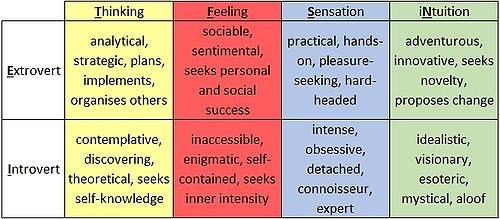
Optimal team grouping
To optimally form a group, it is important to understand what groups do and how they evolve. A group is an organism that constantly reorganize and interact with each other. Groups are formed to solve given tasks and make decisions. This is done by analyzing, searching for potential solutions, analyze potential solutions and at the end make decisions. This means that all individual members of the group must interact with each other and share their knowledge and opinions. If the team member does not know how to interact and share their knowledge with the rest of the team, the group is dysfunctional and can’t perform. It is therefore important to form a group based on the right individuals. This insures that the group can contribute more than the individuals. It is always expected that a group of individuals will perform better than the individuals on their own. The group might have a longer process but the outcome will almost always be better.
When the group is formed the relationships within the group will start to evolve and different individuals might start to take on certain roles. These roles could for example be the leader, the social pleaser, the thinker etc. To ensure that the different roles falls on the individuals best suited for them, it Is critical to have a group that consists of all the different personalities. When a group need to make decisions the optimal way to do this I by using the Z model developed by MBTI®. This model takes advantage of the different personality qualities within the group and based on this a decision process forms. See the figure below.
The MBTI® test
The Myers Briggs Type Indicator is based on the work and theory by Jung. MBTI is based on Jung’s personality types and has further developed the concept. MBTI uses Jung’s intro-extrovert principle and his 4 functions. Too the functions they have chosen to add 2, the perceiving function and the judging function. The basis of the MBTI is therefore:
- Extraversion – introversion
- Sensing – intuition
- Thinking – feeling
- Perceiving – judging
Like Jung’s personality types the underlaying functions is rarely seen and often only when the person is under pressure. The theory behind the MBTI test is much like the theory of Jung’s personality types, just adding the extra dimension of function, the perceiving and judging functions. The theory behind will therefore not be explained in depth.
How to manage different personality’s
Everyone responds to being managed in a different way. But by knowing their personality type it is much easier to do manage them with success. First of all identify the personality of each individual. After this give them feedback, motivation etc. according their personality type.
The following profiles are inspired by Feloni, R. Gould, S. Tieger, P. (2014). How To Manage Every Personality Type. Business Insider, [online].
Judging personality’s
EST
Key characteristics: Practical, realistic, analytical, hardworking, responsible, detail oriented. Very friendly and likes to be in full control of the environment. This type prefers hard facts and logic.
How to motivate:
- Reason only using logical arguments.
- Make sure they know you trust them with the task, completely.
- This type need to see something through from the very beginning to the end.
How to keep their interest and give feedback:
- Make sure all expectations, deadlines etc. are clear.
- Likes responsibility
- Use logical objective feedback
IST
Key characteristics: Thorough, detail oriented, likes facts, serious, focused, good memory, reliable, practical. Works best if given the necessary information, and no more, and deadline. This type always completes task in good time.
How to motivate:
- Likes to know the deadline from the beginning.
- More responsibility.
- Reason only using logical arguments.
How to keep their interest and give feedback:
- Give measurable results and specific feedback.
- Give one task at a time.
- Let the person control how they spend their time.
ESF
Key characteristics: Sympathetic, kind, pleasing, helpful, responsible, organized, avoids conflicts, strong opinions. This type likes to help others and are always conserved for others wellbeing’s. Likes to work closely with others but avoids conflicts.
How to motivate:
- Make sure they know you trust them with the task, completely.
- Appreciate their work on a personal level.
- Praise their need and effort of helping others.
How to keep their interest and give feedback:
- Feedback need to have a positive angle.
- Use examples.
- Provide a soft environment without tension.
- Give more opportunities to work with others.
ISF
Key characteristics: Caring, cautious, don’t like new ideas, sensitive, methodical, fact oriented, likes details. This type takes his responsibilities serious and is very thorough. Likes to help others and is always on duty.
How to motivate:
- Make a personal connection and show interest in the person
- Likes to know the deadline from the beginning.
- Show that their work matters.
How to keep their interest and give feedback:
- Feedback need to have a positive angle.
- Often show that you have a personal connection with them.
- Give specific goals and expectations.
- Give opportunities to work one on one.
ENT
Key characteristics: Friendly, takes charge, outgoing, energetic, creative, innovative and strategic. This type likes to take charge and makes quick decisions. He is very energetic, likes new ideas and people tend to trust him. Tends to see everything as a competition and is therefore a good strategist and leader.
How to motivate:
- Likes competitions and thrive best when in one.
- Challenge him.
- Show them their job prospects.
How to keep their interest and give feedback:
- Show them you know how good they are.
- Ask for their opinions and ideas.
- Be diplomatic but direct.
- Likes the opportunity to meet goals within a timely period.
INT
Key characteristics: Innovative, high standards, independent, logical, analytical and innovative. This type needs to control their time by themselves. They are very innovative and believes in their own ideas, this is what thrives them to reach the goal.
How to motivate:
- Make clear what standard of work you expect.
- Intellectually challenge them.
- Show them what to do to get a career advantage.
How to keep their interest and give feedback:
- Let the person control how they spend their time.
- Ask for their opinions and ideas.
- Provide opportunities to make new solutions for complicated issues.
- Give them opportunity to evolve their competences.
ENF
Key characteristics: Good communicator, enthusiastic, sensitive and compassionate. Likes to help others and are very aware of other’s needs. Good at finding solutions which helps others’. Likes to have a plan they can follow.
How to motivate:
- Praise them often.
- Show a personal interest in their wellbeing.
- Support them in all possible ways.
How to keep their interest and give feedback:
- Give feedback in a two-way manor, not one-way.
- Make a personal connection and show that they have your undivided attention.
- Give opportunities for working with something they care about.
- Provide a supporting and caring working environment.
INF
Key characteristics: sensitive, perfectionistic, focused, committed, deep feelings, good listener, creative and hardworking. This type is very good at finding creative solutions to given problems. They like to analyze the situation before acting and wants to be respected.
How to motivate:
- Praise them for their ideas, preferably in public.
- Show a personal interest in them.
- Show that you respect them.
How to keep their interest and give feedback:
- Be careful about criticizing them, and only do so after lots of praising.
- If possible e-mail them, they like to communicate in writing.
- Give opportunities for working with something they care about.
- Give opportunities to use their creativity.
Perceiving personality’s
EST
Key characteristics: Realistic, practical, charming, spontaneous, friendly, playful, last-minute and logical. This type lives in the moment and loves to play, especially with others. They thrive under pressure and can always deliver.
How to motivate:
- Give new environments, experiences and activities frequently.
- Give hands-on problems.
- Show and give immediately rewards and praise.
How to keep their interest and give feedback:
- Use humor and be playful.
- Have a conversation instead of one-way feedback.
- Give a big range of opportunities so that the task and environment often changes.
IST
Key characteristics: Private, quiet, objective, direct, realistic, independent, pragmatic and honest. This type is typically not angry and is often imperturbable. They don’t say much, but what they say is worth listening to.
How to motivate:
- Give new environments, experiences and activities frequently.
- Give hands-on problems.
- Make sure all progress is measurable and show the progress.
How to keep their interest and give feedback:
- Be logical in your feedback
- Appeal to their thoughts and not their emotions.
- Give measurable tasks.
- Opportunities to do work where they can be physically active.
ESF
Key characteristics: Engaging, impulsive, flexible, fun, playful, spontaneous and good memory. This type loves to help others and often set aside their own goals to help others achieve theirs. They don’t like conflicts and will go a long distance to avoid these. They are very good at remembering small details, conversations and situations.
How to motivate:
- Make a personal connection with them.
- Give hands-on problems.
- Make sure all progress is measurable and show the progress.
How to keep their interest and give feedback:
- Feedback need to have a positive angle.
- Be fun, fast and unpredictable.
- Give a big range of opportunities so that the task and environment often changes.
- Provide a supporting and caring working environment.
ISF
Key characteristics: sensitive, calm, gentle, observant, curious and very private. This type talks soft and is down-to-earth. The general conception of them is often that they are detached but in fact they are nurturing and caring. They want all relationships to be harmonious.
How to motivate:
- Give hands-on problems.
- Give instant praise and rewards.
- Make sure all progress is measurable and show the progress.
How to keep their interest and give feedback:
- Negative feedback needs to be delivered with delicacy.
- Give them time to think before they respond.
- Show your appreciation frequently.
- Let them work independently but in fun environments.
ENT
Key characteristics: Enthusiastic, clever, strives, charismatic, outspoken, loves to debate. This type loves excitement and to be challenged. They are often good at a big verity of things and is intrigued by possible value and inspiration sources. They are good at spotting flaws and hulls in arguments.
How to motivate:
- Likes competitions and thrive best when in one.
- Challenge them.
- Praise them often in public.
How to keep their interest and give feedback:
- Show them you know how good they are.
- Ask for their opinions and ideas.
- Be diplomatic but direct.
- Show them their professional prospects.
INT
Key characteristics: Highly intellectual, logical, creative, skeptical, high standards and independent. This type is very good at solving conceptual problems. They are skeptical of everything and tends to overcomplicate many situations. They use only logical reasoning and prefers to work alone.
How to motivate:
- Praise and reward instant.
- Intellectually challenge them.
- Give new intellectual challenges.
How to keep their interest and give feedback:
- Praise their logic and creativeness.
- Ask for their opinion regarding new ideas.
- Provide opportunities to make new solutions for complicated issues.
- Give them opportunity to interact with a minor highly respected group.
ENF
Key characteristics: Curious, energetic, enthusiastic, fun, adaptable, caring, strong values and playful. This type loves come up with new ideas and to share these with others. Their uniqueness and individuality is very important. They base all decisions on their personal values and feelings.
How to motivate:
- Let them use their creative side.
- Provide a supporting and caring working environment.
- Give a big variety of task and environments.
How to keep their interest and give feedback:
- Don’t critique too much, they tend to get overwhelmed.
- Make it a two-way conversation instead of one-way feedback.
- Give opportunities for working with something they care about.
- Give opportunities to use their creativity.
INF
Key characteristics: Perceptive, unique, strong personal values, committed, sensitive, empathetic, hardworking. This type has strong personal values and their uniqueness is important to them. They are often perceived as cold and reserved, but are often sensitive and warm people. They work hard to achieve their goals if these aligns with their personal believes.
How to motivate:
- Give a warm and friendly environment where they feel liked.
- Ask for their opinion.
- Be careful about how they are approached, they are very sensitive.
How to keep their interest and give feedback:
- Be careful about criticizing them, and only do so after lots of praising.
- Make a personal connect with them.
- Praise their creative work often and in public.
- Give them the opportunity to remain in control.
Discussion
The theory is widely accepted, but there will always be critics. Because the theory was developed in the 1970’ by Jung and was never scientifically proven many claims that the theory is not valid. The theory by Jung was developed based on his observations and was in his research supported by anecdotes citing himself. Today it is norm to support scientific observations with studies in controlled environments. But even today it is difficult to prove psychological ideas, and therefore the theory has not yet been proven scientifically.
Another problem with the theory is that, as stated earlier, no person fits perfectly only one personality type. Everyone is a mix of all types, but one type will often fit better than the rest. This makes personality tests more of a guideline than a specific science.
Annotated bibliography
Jung, C. G. (1981). Collected Works of C.G. Jung , 6. Edition.
The original book by C. G. Jung where he published and described his work.
Winch, G. M. (2010). Managing Construction projects, 2. edition
The book describes how to manage construction project based on theory.
P.D. Kitchin (2010). An Introduction to Organisational Behaviour for Managers and Engineers, 1. edition
This book describes how to manage an organization and explains how the workers behave in different environments.
Forsynth, D.R (2006). Group Dynamics, 4. Edition
The book describes group dynamics and how the group will evolve over time.
Feloni, R. Gould, S. Tieger, P. (2014). How To Manage Every Personality Type. Business Insider, [online]. Available at: http://www.businessinsider.com/how-to-manage-every-personality-type-2014-10?op=1&r=US&IR=T&IR=T/#rst-determine-where-your-employees-fit-in-to-each-of-the-four-categories-1 [Accessed 2 Oct. 2017].
The article describes how to manage different personality types.
Study.com. Carl Jung's Theories: Personality, Psyche & Dreams. [online] Available at: http://study.com/academy/lesson/carl-jungs-theories-lesson-quiz.html
[Accessed 2 Oct. 2017].
The website has a class about Jung’s theorys and how he saw the world.
Hall, C. S., & Lindzey, G. (1957). Theories of personality, 1. Edition.
A book about personality theory’s.
Businessballs.com. Personality theories and types. [online] Available at: http://www.businessballs.com/personalitystylesmodels.htm
[Accessed 21 Sep. 2017].
The article describes a big variety of different personality theory’s and tests.
References
- ↑ https://thereisonlygod.wordpress.com/tag/carl-gustav-jung/ retrieved on Sep. 27. 2017
- ↑ Interview with Carl Gustav Jung, https://http://jphonors.weebly.com/archetypes.html retrieved on Sep. 21. 2017
- ↑ 3.0 3.1 Jung, C.G. (1981). "The Archetypes and The Collective Unconscious (Collected Works of C.G. Jung Vol.9 Part 1 )", 6. Edition 1980. Translated by Hull, R.F.C.
- ↑ 4.0 4.1 http://www.businessballs.com/personalitystylesmodels.htm retrieved on Sep. 21. 2017
- ↑ https://www.brainyquote.com/quotes/quotes/c/carljung717968.html retrieved on Sep. 21. 2017
- ↑ https://www.tasklabels.com/disorganized-person/ retrieved on Sep. 21. 2017
